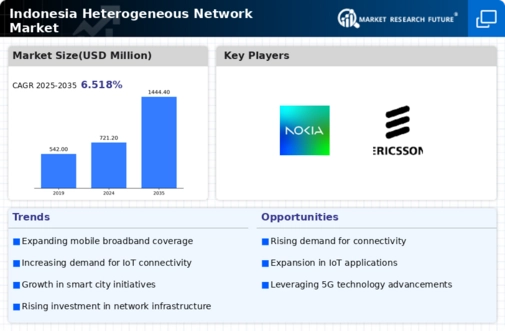Emergence of Smart Cities
The development of smart cities in Indonesia is a pivotal driver for the heterogeneous network market. As urban areas evolve into smart ecosystems, the demand for integrated and efficient communication networks intensifies. Smart city initiatives focus on enhancing public services, transportation, and energy management through technology. By 2025, it is anticipated that several Indonesian cities will implement smart solutions, necessitating the deployment of heterogeneous networks to support diverse applications. This trend indicates a growing market for service providers who can deliver the necessary infrastructure. The heterogeneous network market is likely to thrive as cities embrace digital transformation and seek to improve the quality of life for their residents.
Growth of IoT Applications
The proliferation of Internet of Things (IoT) applications significantly influences the heterogeneous network market in Indonesia. As industries increasingly adopt IoT solutions for automation and data analytics, the demand for reliable and flexible network architectures rises. By 2025, it is projected that the number of connected IoT devices in Indonesia will exceed 200 million, necessitating the deployment of heterogeneous networks to manage the diverse data traffic effectively. This growth presents opportunities for service providers to innovate and enhance their offerings. The heterogeneous network market is thus likely to expand as businesses seek to leverage IoT capabilities for improved operational efficiency and customer engagement.
Increased Mobile Data Consumption
Mobile data consumption in Indonesia is on an upward trajectory, driven by the widespread use of smartphones and mobile applications. As of 2025, mobile data traffic is expected to grow by over 50%, prompting the need for advanced network solutions. Heterogeneous networks, which combine various access technologies, are well-suited to handle this surge in demand. They enable operators to optimize resource allocation and enhance user experiences across different devices. The heterogeneous network market is poised to capitalize on this trend, as it provides the necessary infrastructure to support the increasing mobile data requirements of consumers and businesses alike.
Government Initiatives and Policies
Government initiatives play a crucial role in shaping the heterogeneous network market in Indonesia. The Indonesian government has launched several programs aimed at enhancing digital infrastructure, including the National Broadband Plan. This initiative aims to provide high-speed internet access to remote areas, thereby fostering inclusivity. By 2025, the government targets a 50% increase in broadband penetration, which is likely to stimulate investments in heterogeneous networks. These networks are essential for accommodating the diverse needs of urban and rural populations alike. The heterogeneous network market stands to gain from these policies, as they create a conducive environment for technological advancements and infrastructure development.
Rising Demand for High-Speed Connectivity
The heterogeneous network market in Indonesia experiences a notable surge in demand for high-speed connectivity. As urbanization accelerates, the need for robust internet services becomes paramount. The increasing reliance on digital platforms for business and education drives this demand. According to recent data, approximately 70% of Indonesian households are expected to have internet access by 2025, highlighting the urgency for enhanced network capabilities. This trend compels service providers to invest in heterogeneous networks, which integrate various technologies to deliver seamless connectivity. The heterogeneous network market is thus positioned to benefit from this growing consumer expectation, as it enables faster data transmission and improved user experiences across diverse applications.

















Leave a Comment